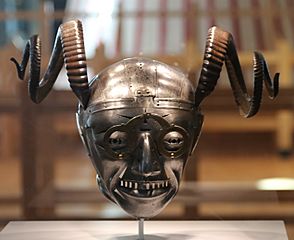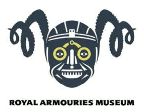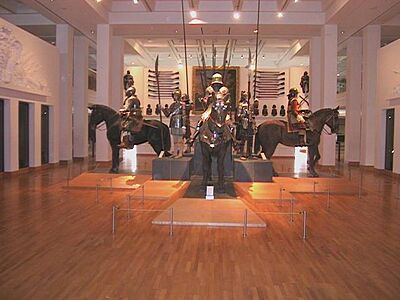Royal Armouries Museum facts for kids
 |
|

The Royal Armouries Museum and Knight's Way Bridge
|
|
| Lua error in Module:Location_map at line 420: attempt to index field 'wikibase' (a nil value). | |
| Established | 1996 |
|---|---|
| Location | Leeds Dock, Leeds, LS10 England |
| Type | National museum |
| Visitors | 240,000 (2019) |
| Public transit access |
|
The Royal Armouries Museum in Leeds, England, is a special national museum. It is home to the amazing National Collection of Arms and Armour. This means it has a huge collection of weapons and armor from different times and places!
The museum is part of the larger Royal Armouries family. Other parts of this family include the historic Tower of London and the National Collection of Artillery at Fort Nelson, Hampshire. The Royal Armouries Museum in Leeds opened in 1996. It was built especially to show off these incredible items. Before this, many of the items were kept at the Tower of London.
Just like other national museums in the UK, it's free to enter! However, some special activities might have a small charge.
Contents
Building the Museum
The Royal Armouries Museum was a big project. It was designed by Derek Walker and Buro Happold. Alfred McAlpine built the museum, and it cost about £42.5 million. Queen Elizabeth II officially opened the museum in March 1996.
Where to Find the Museum
The museum is located near the center of Leeds, right by the River Aire. It's a key part of the updated Leeds Dock area. You can find it on Armouries Square.
What You Can See Inside
Main Museum Building
The museum was designed with its amazing collection in mind. For example, the ceilings are very tall, about 6.5 meters high! This allows them to display long weapons standing upright.
Besides the main galleries, there's also the Hall of Steel. This is a giant staircase with walls covered in 2,500 objects. It looks like the old displays of weapons that were set up at the Tower of London centuries ago.
War Gallery
This gallery shows how people fought in different times. You can explore:
- Battles from ancient times and the Middle Ages.
- Weapons and armor from the 17th and 18th centuries.
- Items from the 19th and 20th centuries.
Peace Gallery
This special gallery is inside the War Gallery. It makes you think about a future without weapons. It explores ideas like disarmament, which means reducing or getting rid of weapons. This gallery works with the Peace Museum in nearby Bradford.
Africa & Asia Gallery
This gallery features arms and armor from different parts of the world, including:
- South and South-east Asia.
- China and Japan.
- Central Asia, Islam and India.
Tournament Gallery
This is a large gallery spread over two floors. It showcases many types of arms and armor from the exciting days of jousting. You can imagine knights in shining armor!
Self-Defence Gallery
This gallery has several interesting displays:
- It shows how arms and armor can be seen as art.
- It looks at how everyday people used weapons for protection.
- There's also an exhibition called "Make: Believe." This explores how weapons and armor appear in movies and games, and how popular culture can even inspire new designs.
The Tiltyard Arena
Next to the River Aire is a long arena, about 150 meters long. This is where exciting jousting contests happen! Even though the museum doesn't have its own horses anymore, knights from all over the world still come to compete here twice a year.
The biggest event is at Easter. For four days, teams of jousters compete in an international tournament. In the Summer, the jousting season ends with a final competition. Jousters compete individually for The Queen's Golden Jubilee Trophy.
Exhibits








